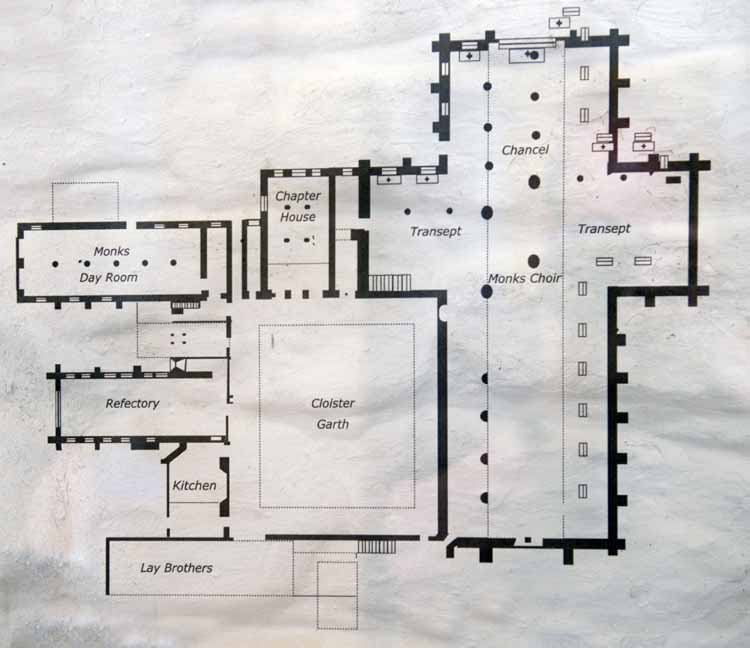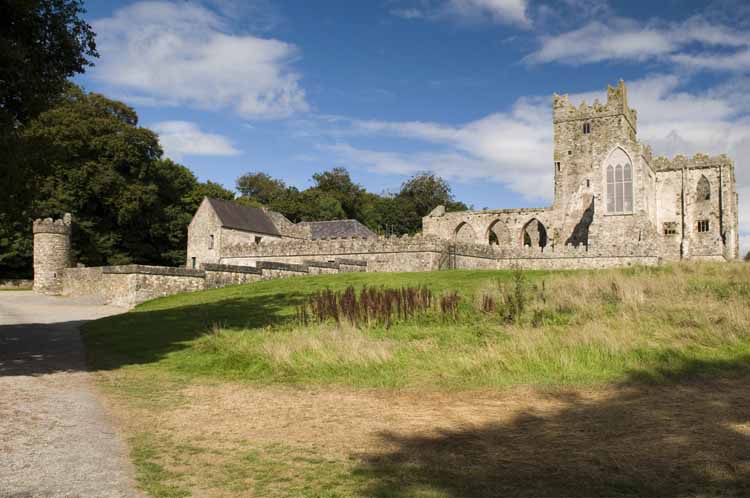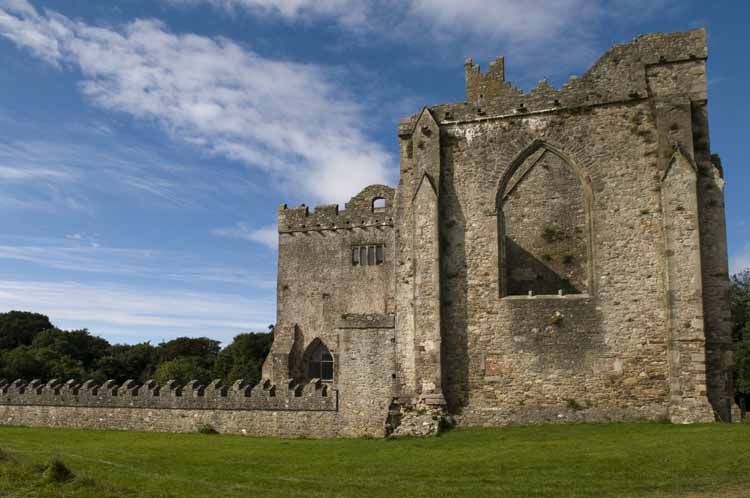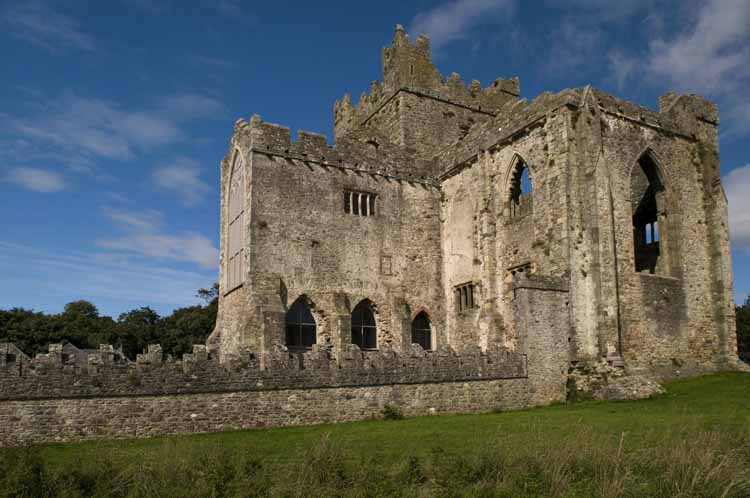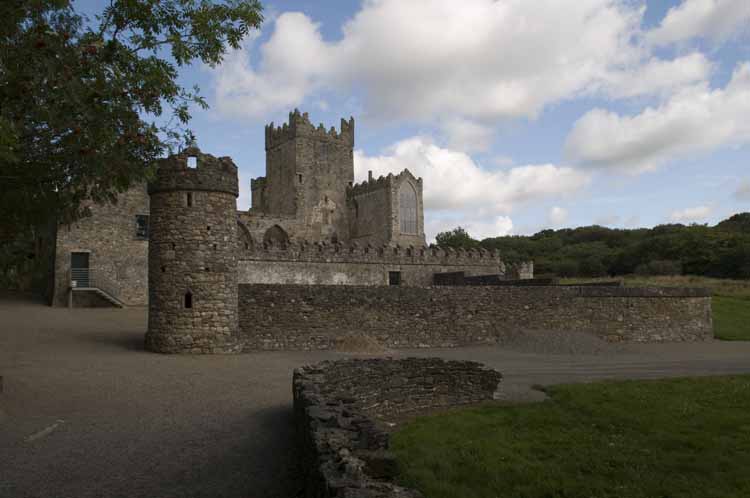Cistercian Abbey of Tintern de Voto, County Wexford, Ireland,
was founded by William Marshal, earl of Pembrokeshire and Lord of
Leinster. Tradition says that during a journey to Ireland William
encountered a violent storm and vowed to found an abbey wherever he
could safely land. William finally reached safety at Bannow Bay and
he subsequently bequeathed about 9000 acres of land to the monks of
Tintern Abbey in Wales, of which he was patron. A colony of monks
arrived from Tintern in the autumn of 1200. The abbey is sometimes
referred to as Tintern de Voto, which means ‘Tintern of the vow’.
Following its foundation, Tintern acquired vast tracts of land in
County Wexford, and it soon became one of the wealthiest of the
Cistercian houses in Ireland.
The monks of Tintern, who were Anglo-Norman in origin,
supported the Cistercian General Chapter during the ‘conspiracy of
Mellifont’. In 1228 Stephen of Lexington held an assembly of Cistercian
abbots at Tintern, after he had conducted two visitations of the Irish
abbeys. In 1277 the abbot of Tintern was deposed for his failure to
attend the General Chapter for many years. Towards the end of the
thirteenth century the original stone church was abandoned and replaced
with a new one. In 1477 it was reported that the lands were much wasted
and the abbot rebuilt the abbey at great cost to himself. At the time of
the Dissolution the annual income of the abbey was valued at £96, which
made it the third richest Cistercian house in Ireland, after St. Mary’s
Dublin and Mellifont.
King John's confirmation of a grant by Marshal of thirty plough lands
for the foundation of the abbey was made in 1200, but Marshal's actual
charter can be dated to 1207-13 from the names of the witnesses. The
land granted to the Cistercians was part of Hervey de Montmorency's
fief, but it reverted to Marshal after Hervey's death in 1205. This may
have delayed the conferring of a charter of foundation following the
initial grant of land in 1200. Of nine place-names mentioned in the
charter to Tintern, four can be identified in the modern landscape. The
land was described as 'next the water of Bann[ow]' and to the 'west of
Auanduff,' a reference to the Owenduff river, which formed the eastern
boundary of the estate. The town lands of Rathumney and Dunmain, also
mentioned in the charter, were the sites of granges on the monastic
estate. By using this information in conjunction with the extent of the
foundation's possessions in 1539, it is possible to estimate the extent
of the lands granted by Marshal.The monastic estate, equivalent to the
civil parishes of Tintern and Owenduf, contained almost 15,000 statute
acres (6,070 ha), or approximately fifty plough lands. This is
considerably more than the thirty mentioned in the charter, suggesting
that the plough lands of the charter contained a larger acreage,
possibly comprising wasteland and forest; as at Dunbrody, the original
grant may also have been augmented by grants of land from other sources.
According to the charter, a considerable part of the land had formerly
been held by other individuals, presumably tenants-at-will, who were
removed to make way for the Cistercians. It was not possible to remove
established tenants from all of the land, as the grant to the
Cistercians was divided in two by the parish of Kinnagh. The abbey was suppressed in 1536, but the monks remained at the abbey
for some years following. In 1541 the royal commissioners reported that
the abbey church had been used for parochial purposes for some time
prior to the Dissolution, and that all other buildings were necessary
for the farmer. In the 1550s the property passed to Anthony Colclough,
an officer in Henry VIII’s army. Colclough converted the crossing tower
into a fortified residence and subsequently he, or one of his immediate
successors, converted the chancel into another dwelling house. In the
eighteenth century, Sir Vesey Colclough constructed a series of
embattled walls around the abbey and in the 1790s John Colclough
converted the nave into a residence in the neo-gothic style. The last
member of the family to reside in the abbey was Lucey Marie Biddulph
Colclough who left in 1959. Four years later the property was taken into
state care. Conservation work was begun in the 1980s and extensive
excavations took place in 1982-3. They revealed much of the foundation
work and exposed many of the features of the original abbey. The remains
include the nave, chancel, tower, chapel and cloister. The chancel at
Tintern is nothing more than a shell and the tracery of the windows has
long been torn away. There is a well-preserved exterior corbel table and
the south transept has a rib-vaulted eastern aisle originally divided
into three separate chapels. Tintern de Voto (of the Vow) or Parva (minor or small) is located on
the southern coast of County Wexford. By the sixteenth century the abbey
had become dilapidated and much of its landholding had either been
abandoned, laid-waste or captured by the “rebellion of the Irish”
(White). Tintern was suppressed in 1536 on the orders of Henry VIII and
the sales of chattels raised a trifling £13 9/4d. Sir Anthony Colclough
acquired the estate with the condition that the house must be fortified
and that he retain three English horsemen and four archers for its
defence. During the post-dissolution period the architecture changed
radically when most of the monastic buildings were quarried for blocks
to build the manor’s fortifications (Lynch). The east, west and south
ranges were demolished along with the northern aisle and transept and
only the mid-section of the church, the southern aisle and transept,
parts of the cloister and gatehouse remained (Fig. 3.2.2). The house was
in continuous occupation by the Colclough family until 1959 when it was
given into the care of the Commissioners of Public Works. The buildings
were dilapidated and a decision was made to remove the post-dissolution
additions and to reinstate the site as a medieval Cistercian ruin.
During the rebuilding work, between 1982 and 2007, an extensive
excavation was undertaken which was recorded in a detailed monograph.
Until Tintern de Voto was excavated the structure, economy and household
of the monastery could only be theoretically reconstructed using the
corpus of information from other abbeys in Britain and Europe. The
site‘s archaeological record is challenging to decipher because of
Tintern’s demolition and overbuilding but the excavations have been able
to confirm that some features, material remains and burials survived.
Sources:

Colfer, B. 2004. The Hook Peninsula, Cork: Cork University Press.
Lynch, A. 2010. Tintern Abbey, Co. Wexford, Cistercians and Colcloughs. Excavations 1982-2007, Dublin:
Archaeological Monograph Series.
Stalley, R. 1987. The Cistercian Monasteries of Ireland, London:
Yale University Press.
University of Sheffield -
The Cistercians in Yorkshire
Project.
White, N. 1943. Extents of Irish Monastic Possessions, 1540-1541, Dublin: Irish Manuscripts Commission.
